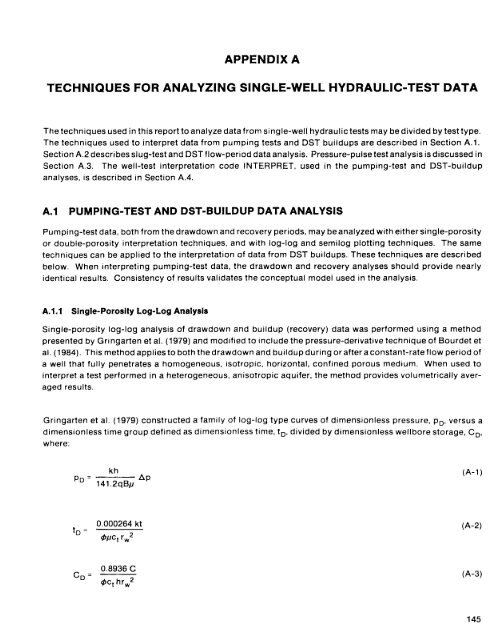Beauheim 1987 - Waste Isolation Pilot Plant - U.S. Department of ...
Beauheim 1987 - Waste Isolation Pilot Plant - U.S. Department of ...
Beauheim 1987 - Waste Isolation Pilot Plant - U.S. Department of ...
You also want an ePaper? Increase the reach of your titles
YUMPU automatically turns print PDFs into web optimized ePapers that Google loves.
APPENDIX A<br />
TECHNIQUES FOR ANALYZING SINGLE-WELL HYDRAULIC-TEST DATA<br />
The techniques used in this report to analyze data from single-well hydraulic tests may be divided by test type.<br />
The techniques used to interpret data from pumping tests and DST buildups are described in Section A.1.<br />
Section A.2 describes slug-test and DST flow-period data analysis. Pressure-pulse test analysis is discussed in<br />
Section A.3. The well-test interpretation code INTERPRET, used in the pumping-test and DST-buildup<br />
analyses, is described in Section A.4.<br />
A.l<br />
PUMPING-TEST AND DST-BUILDUP DATA ANALYSIS<br />
Pumping-test data, both from the drawdown and recovery periods, may beanalyzed with either single-porosity<br />
or double-porosity interpretation techniques, and with log-log and semilog plotting techniques. The same<br />
techniques can be applied to the interpretation <strong>of</strong> data from DST buildups. These techniques are described<br />
below. When interpreting pumping-test data, the drawdown and recovery analyses should provide nearly<br />
identical results. Consistency <strong>of</strong> results validates the conceptual model used in the analysis.<br />
A.1.l<br />
Single-Porosity Log-Log Analysis<br />
Single-porosity log-log analysis <strong>of</strong> drawdown and buildup (recovery) data was performed using a method<br />
presented by Gringarten et al. (1979) and modified to include the pressure-derivative technique <strong>of</strong> Bourdet et<br />
at. (1984). This method applies to both the drawdown and buildup during or after a constant-rate flow period <strong>of</strong><br />
a well that fully penetrates a homogeneous, isotropic, horizontal, confined porous medium. When used to<br />
interpret a test performed in a heterogeneous, anisotropic aquifer, the method provides volumetrically averaged<br />
results.<br />
Gringarten et al. (1979) constructed a family <strong>of</strong> log-log type curves <strong>of</strong> dimensionless pressure, p, versus a<br />
dimensionless time group defined as dimensionless time, tD. divided by dimensionless wellbore storage, C,<br />
where:<br />
kh<br />
141.2qBp AP<br />
PO =<br />
0.000264 kt<br />
tD =<br />
@w, rw2<br />
(A-2)<br />
(A-3)<br />
145

















